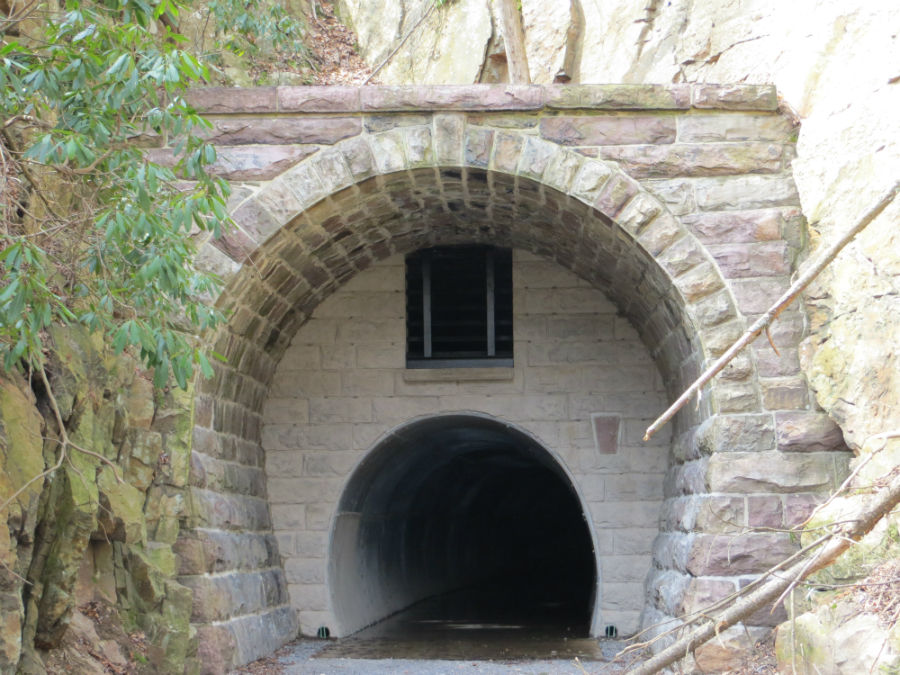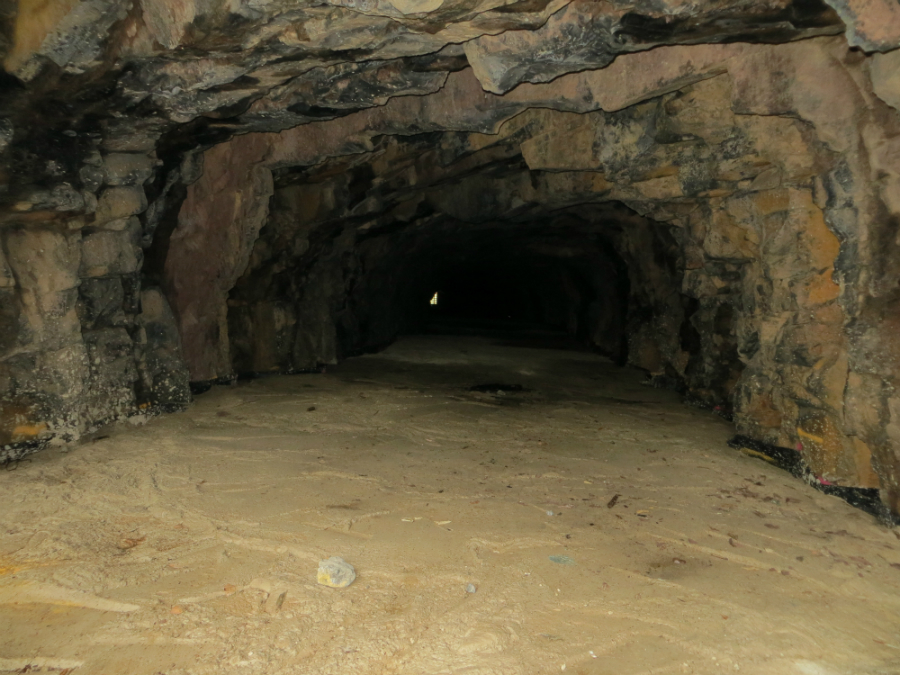Maintaining Tunnel Cohabitants
Jerry Silagyi, P.E.
 Curved structural steel plates form an arch tunnel for hikers. Bat-friendly gates above each end of the tunnel are designed to American Cave Conservation Association and Bat Conservation International standards.
Curved structural steel plates form an arch tunnel for hikers. Bat-friendly gates above each end of the tunnel are designed to American Cave Conservation Association and Bat Conservation International standards.
Often, the application of structural plate pipe products serves to meet some unusual needs. On occasion, those needs include provisions for the passage of aquatic life or other critters. The Poe Paddy Tunnel reline included a symbiotic feature for a most peculiar cohort — bats, especially the state threatened eastern small-footed bat.
The tunnel was originally part of the Lewisburg and Tyrone Railroad, which began operation around 1880. The historic railway was abandoned by Penn Central in 1970 and the tunnel became a critical link in the Mid State Trail (MST), commonly known as the “Wildest Trail in Pennsylvania,” extending from Maryland to New York and bisecting central Pennsylvania.
The MST has come to epitomize the Pennsylvania trail system, and the Poe Paddy Tunnel is the heartbeat of its activity, serving not only as a pass through West Paddy Mountain in the heart of Bald Eagle State Forest, but also as an all-important throat of a peninsula formed by Penns Creek, where some of the best trout fly-fishing in the Northeast can be found.
Anglers, floaters, hikers, bikers, campers, and hunters alike are commonplace traffic throughout the day, but the tunnel has also become known as a thriving bat hibernaculum. The old tunnel was originally blast constructed to an internal height of approximately 20 feet and the resultant cracks, crevices, and craggy surfaces were ideal for housing the hanging creatures.
The Poe Paddy Tunnel was first documented to house bats in 1995, hosting five out of the six hibernating bat species — the federally threatened long-eared bat, the state threatened small-footed bat, the tri-colored bat, the little brown bat, and the big brown bat. It also occasionally hosts the silver-haired bat, a very rare spectacle as this migrating species is more prone to spending winter months further south.
At a time when bat populations are experiencing record declines across North America, this location was experiencing quite the opposite, and the project had to ensure provisions were made to maintain this welcomed phenomenon. A feature that made this site conducive to bat populations was the naturally occurring airflow through the tunnel. Another feature was the groundwater seepage from the overlying stratums providing needed humidity, while pooling in several areas to allow the bats to get their drink on the fly. With one end of the tunnel opening being smaller than the other, the airflow was nicely throttled to regulate temperature and humidity in a manner very accommodating to the bats.
With closure of the tunnel in early 2013, the reline was primarily needed to address safety concerns associated with falling rock in the popular Pennsylvania trail tunnel. With the added necessity of maintaining the bat environ, the project involved construction of two separate habitats — one to house the flying mammals and the other to pass the forest pedestrians.
Corrugated steel structural plate (by Lane Enterprises, Pulaski, Pa.) was the tunnel reline material of choice. Although more commonly used in large road culvert and small bridge applications, structural plate is increasingly becoming known as the more viable reline material for rehabilitating large buried conduit.
 Space below the tunnel ceiling creates a hibernation cave for bats. Concrete fills the annular space between the existing tunnel and the top of the new structural steel plate arch, extending, when completed, at least one foot above the arch to form a floor to the hibernation cave.The window for construction activities was limited to the period when the bats vacated the tunnel for the year, contractually defined between May 1 and October 1, 2015. To provide additional safety from falling rocks, installation of the plate liner was designed to begin outside the north end of the tunnel roughly 50 feet from the existing rock sheer-faced opening where a new headwall was constructed. This portion of the tunnel was backfilled with crushed stone to an elevation that preserved a small natural opening in the rock face where the smaller of the two bat-friendly gates was installed.
Space below the tunnel ceiling creates a hibernation cave for bats. Concrete fills the annular space between the existing tunnel and the top of the new structural steel plate arch, extending, when completed, at least one foot above the arch to form a floor to the hibernation cave.The window for construction activities was limited to the period when the bats vacated the tunnel for the year, contractually defined between May 1 and October 1, 2015. To provide additional safety from falling rocks, installation of the plate liner was designed to begin outside the north end of the tunnel roughly 50 feet from the existing rock sheer-faced opening where a new headwall was constructed. This portion of the tunnel was backfilled with crushed stone to an elevation that preserved a small natural opening in the rock face where the smaller of the two bat-friendly gates was installed.
The curved plates were assembled and bolted in place to form the 11-foot, 9-inch by 9-foot, 11-inch arch. The 307-foot curvilinear alignment needed 10 course corrections to maintain the tunnel curvature from one end to the other, easily accommodated through specially fabricated elbow-type fittings provided by the manufacturer.
To accommodate the bats, the design included preservation of 5 to 7 feet of space below the tunnel ceiling for a hibernation cave. Concrete was pumped through the opening left in the south headwall, filling the annular space between the existing tunnel and the new arch and extending in height a minimum of one foot above the arch to form a floor to the cave, with several 3- to 6-inch depressions to allow water pooling.
The renovation was complete with the installation of bat-friendly gates at each end of the tunnel, designed to American Cave Conservation Association and Bat Conservation International standards, with access provisions included on the north gate for hibernacula survey (gate designs by Chris Sanders, Sanders Environmental). The different type and sized openings work together to regulate air flow, mimicking what was naturally occurring before the renovation.
Post-construction monitoring showed comparable humidity and temperature levels were maintained, and a recent hibernacula survey indicated a significant increase in the total number of bats using the site compared with a 2014 survey.
The success and importance of this project was further evidenced during a May 2016 dedication ceremony where numerous attendees and speakers gathered to celebrate the project completion alongside a continuous stream of foot and bike traffic through the renovated tunnel in the heart of Bald Eagle State Forest. Renovation of the Poe Paddy Tunnel highlights the cooperative venture of state agencies, commissions, and associations to meet the safety needs of the public while preserving and protecting a unique aspect of its environment. Congratulations to the cooperative undertakings of the Pennsylvania Department of Conservation and Natural Resources and its partners for a job well done. Happy trails!
Design Team and Partners
- Pennsylvania Department of Conservation and Natural Resources (PA DCNR):
- Bureau of Facility Design and Construction
- Bureau of Forestry
- Bureau of State Parks
- Pennsylvania Game Commission
- Pennsylvania Fish & Boat Commission
- Keystone Trails Association
- AECOM (Pittsburgh)
Construction Team
- PA DCNR Bureau of Facility Design and Construction
- Jay Fulkroad & Sons, Inc. (McAlisterville, Pa.)
Jerry Silagyi, P.E., is the chief engineer at Lane Enterprises, Inc., based in Camp Hill, Pa. He also currently serves on the board of directors for the National Corrugated Steel Pipe Association (http://ncspa.org).








